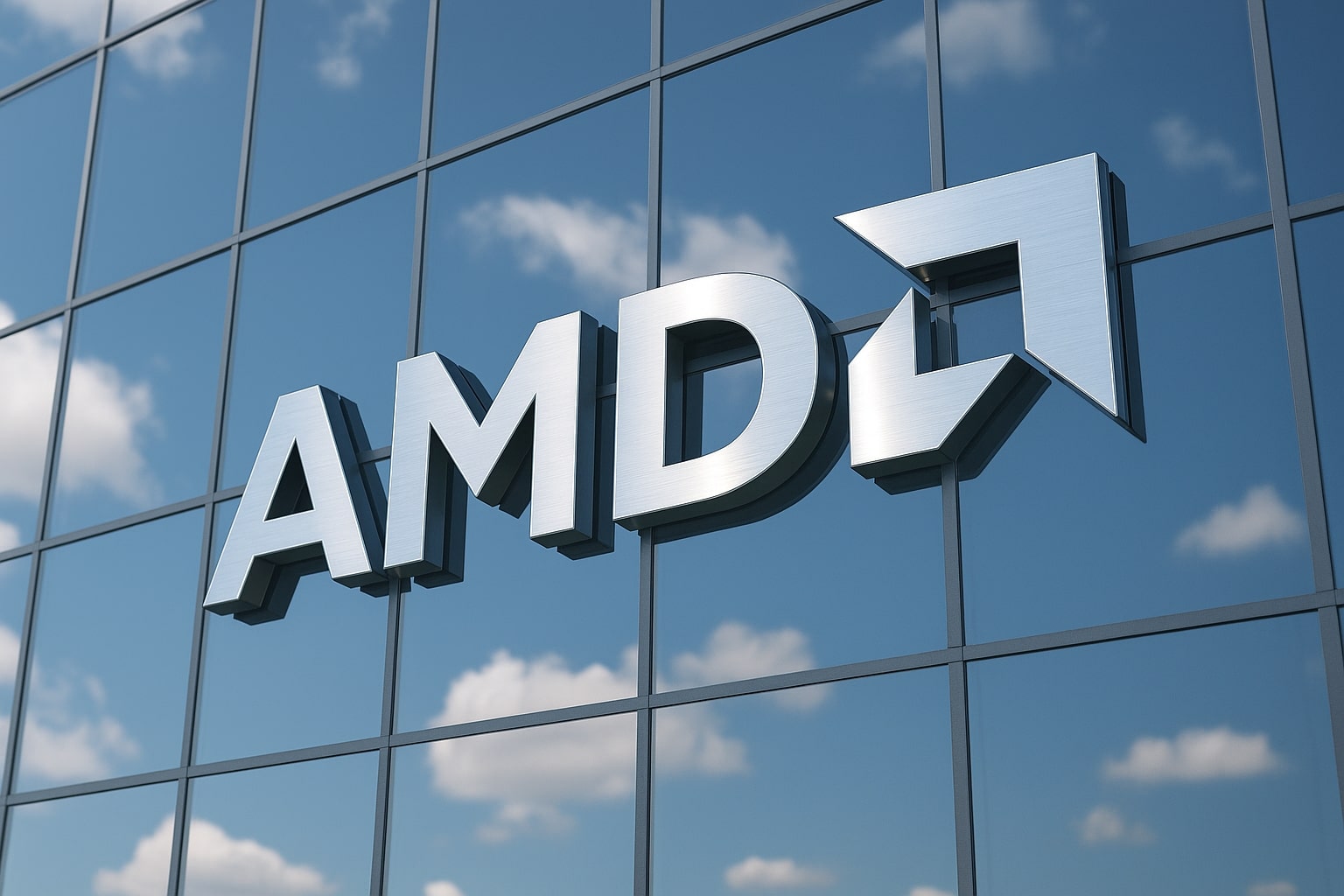
AMD Stock Price Forecast - AMD Shares Gains on $9.2B Q3 Surge
Advanced Micro Devices posts 36% YoY revenue growth, strengthens its data center and AI roadmap toward a $1 trillion compute market | That's TradingNEWS
AMD (NASDAQ:AMD) Surges on AI Growth, Expanding Data Center Dominance, and Long-Term Upside Potential
AI Acceleration Redefines NASDAQ:AMD’s Competitive Position Against Nvidia
Advanced Micro Devices (NASDAQ:AMD) has moved beyond being a cyclical chipmaker and has evolved into a structural AI and data center growth story. The company’s Q3 2025 results confirm this shift, reporting revenue of $9.2 billion, a 36% year-over-year increase, alongside a sequential improvement of roughly 20%. Gross margin rose to 52% GAAP and 54% non-GAAP, while earnings per share reached $1.20, comfortably beating market expectations. The strength came from a broad base, with data center, client, and gaming all expanding sharply.
AMD’s AI strategy is anchored on its MI450 accelerator and the Helios rack-scale systems, both built on TSMC’s 2 nm process and expected to begin deployment in late 2026. These products aim to capture the surging demand for inference workloads, an area expected to outpace training as AI systems scale across global infrastructure. The company projects an 80% compound annual growth rate in AI-related revenue over the next five years, while independent models place it at 62% CAGR through 2030, reaching 10% of the global AI compute market from 4% today.
Revenue Expansion Across Segments Highlights AMD’s Broad-Based Momentum
The data center division remains AMD’s growth core, delivering $4.3 billion in Q3 2025, up 22% year-over-year, with the company’s EPYC CPUs now adopted by all 10 major hyperscalers and over 60% of the Fortune 100. Market share currently sits near 40%, with a clear path to 50% by 2030.
The Client and Gaming divisions jointly contributed $4 billion, a 73% year-over-year jump. Ryzen 9000 desktop and mobile CPUs lifted the Client segment by 46% to $2.75 billion, while Gaming revenues climbed 181% to $1.3 billion thanks to strong GPU and semi-custom chip sales. Although the Embedded segment softened by 8% to $857 million, AMD expects renewed growth in semi-custom silicon and industrial compute through 2026.
At the corporate level, the firm forecasts 31% total revenue CAGR through 2030, climbing from $44.8 billion in 2026 to $126.6 billion by 2030. This projection excludes China from growth assumptions, underscoring AMD’s confidence in organic expansion across North America and Europe.
Profitability and Capital Allocation Reinforce AMD’s Scalable Model
Profit margins continue to expand alongside scale. Management expects gross margins to stabilize around 53% by 2030, supported by product optimization and AI mix expansion. R&D intensity remains high, with projected growth of 14% annually through 2030, while selling and administrative expenses are modeled to increase at 16% annually as AMD strengthens its market position in enterprise AI. The tax rate is expected to decline from 19% to 17%, improving post-restructuring of its global entities.
Operating margins are forecast to rise toward 38% by 2034, while free cash flow yield remains at 1.6% in 2025 but could exceed 4% once the AI portfolio reaches scale. AMD’s heavy reinvestment in innovation ensures near-term margin pressure but positions it for stronger operating leverage after 2026.
AI and Data Center Drive Structural Expansion Beyond Cyclical Trends
AMD’s long-term transformation revolves around its Data Center and AI division, which now defines its investment thesis. The total addressable market for compute and data infrastructure was expanded to $1 trillion by 2030, up from earlier estimates of $500 billion by 2028. AMD’s ROCm 7 open-source software ecosystem is central to its competitive edge, delivering 4.6× improvement in training and 3× improvement in inference versus previous versions. This directly challenges Nvidia’s CUDA framework by offering enterprises a flexible, vendor-agnostic alternative for large-scale AI deployment.
The Helios rack-scale system complements AMD’s MI300 and MI400 series accelerators, positioning the company as a credible second-source alternative to Nvidia in the enterprise AI market. The approach mirrors the structural advantage AMD established in CPUs with EPYC—leveraging open ecosystems, scalability, and high efficiency at lower total cost of ownership.
Valuation Models Suggest Significant Upside Even Under Conservative Scenarios
A 10-year discounted cash flow model places AMD’s base-case fair value at $269.4 per share, implying upside from current levels near $214. The conservative case yields $171.2, while the optimistic scenario approaches $347.1.
Key modeled assumptions include 31% CAGR through 2030, a 53% gross margin, a 38% EBIT margin by 2034, a 3% perpetual growth rate, and a 10.3% WACC. On this basis, AMD qualifies as a Buy under $211, where its undervaluation, forward revenue growth, and free cash flow yield together exceed the company’s 60% uncertainty threshold.
The long-term valuation gap between AMD and Nvidia remains tied to execution speed. If AI deployments progress on time, AMD’s fair value could re-rate toward $270–$300 by 2026, particularly as margins expand with higher data center mix.
Technical Structure Indicates Controlled Consolidation Before a New Breakout
AMD stock trades near $214.24, after touching highs of $215.57. The price action reflects consolidation following a multi-month rally from the $160 support zone. Technically, the key support sits around $200, with resistance at $218.50 and breakout confirmation above $230.00.
Momentum remains bullish, with the potential for retracement toward $205–$210 before resuming the upward trend. Chart patterns suggest the next rally phase could push toward $260–$300, aligning with the fair value range modeled by long-term projections.
Risk Profile Highlights Execution and Competitive Pressures
The primary risk is execution timing. Revenue from the MI450 AI systems will not materially impact earnings before late 2026, leaving a four-quarter window of slower growth. Competitive risk also persists, as NVIDIA, Google, and Meta continue to develop proprietary architectures. A delay in AMD’s rollouts or weaker AI adoption could compress multiples.
Cyclicality in the Embedded and Gaming segments remains another exposure. Elevated R&D and marketing costs could cap short-term operating leverage if revenue growth moderates. Still, AMD’s liquidity position, balance sheet strength, and disciplined reinvestment mitigate severe downside.
Read More
-
Robinhood Stock Price Forecast - HOOD Shares Rockets Past $128 After 270% Profit Jump
27.11.2025 · TradingNEWS ArchiveStocks
-
XRP ETFs (NASDAQ:XRPI, NASDAQ:XRPR) Cross $644M AUM as XRP-USD Climbs to $2.18
27.11.2025 · TradingNEWS ArchiveCrypto
-
Natural Gas Price (NG=F) Rises Toward $4.60 as Cold Weather and Record LNG Exports
27.11.2025 · TradingNEWS ArchiveCommodities
-
Stock Market Today - Dow 47,427 and Nasdaq 23,214 — Fed Cut Bets Power DELL, HOOD, and URBN in Holiday Rally
27.11.2025 · TradingNEWS ArchiveMarkets
-
USD/JPY Price Forecast - (Dollar–Yen) Steadies at 156.30 as Japan’s ¥21.3 Trillion Stimulus
27.11.2025 · TradingNEWS ArchiveForex
Verdict – Buy Rating Reaffirmed as AMD Solidifies Its Position in Global AI Infrastructure
The combination of financial performance, AI leadership momentum, and structural expansion across data centers makes Advanced Micro Devices (NASDAQ:AMD) a compelling long-term opportunity. With a base-case fair value of $269.4 and current levels below $215, AMD remains undervalued relative to its multi-year potential. Its positioning as the second-source alternative to Nvidia in AI hardware, supported by strong CPU share gains and open-source software adoption, validates a Buy stance. Execution will determine the pace of re-rating, but the trajectory toward $260–$300 remains intact for 2026 as AMD’s AI revenue inflection begins to materialize.



















